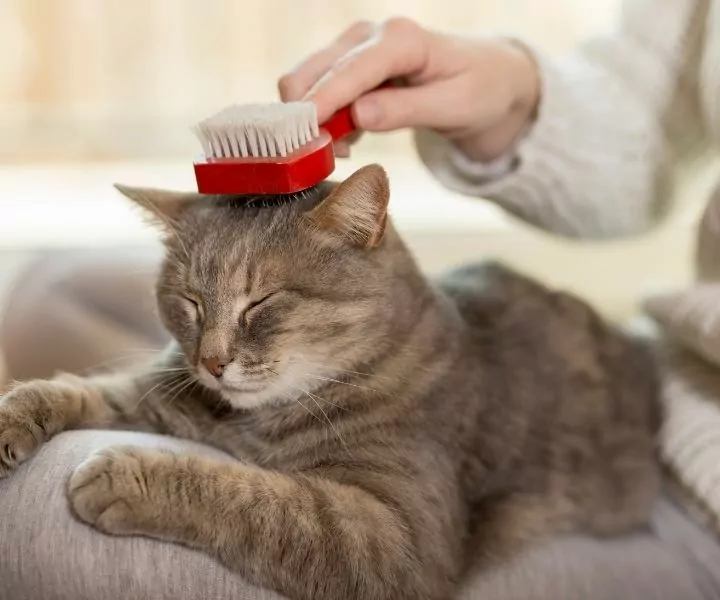What Does it Mean When My Cat is Getting Hairballs?
When you notice that your cat is getting hairballs, you might be concerned that they have a problem, this is always the case, but it is good to be informed about hairballs.

The first place to start is, what is a hairball? A hairball, otherwise known as a furball, is a ball of hair that collects in a cat’s stomach after they groom themselves. Hair cannot be easily digested, so it can accumulate into a ball and be brought up (regurgitated) if there is any difficulty in having it pass through the digestive tract. The hairball often comes out as a long tube of matted fur. This would have been sitting in the stomach, unable to continue to the intestines.
Hairballs are very common but can be a sign of a problem with your cat, and some things can be done to prevent them. Today we are going to answer all your questions and concerns regarding hairballs.
The Causes of Hairballs in Cats
As a cat grooms itself, its cat tongue collects loose fur and helps groom out knots and prevent mats. The loose fur will sometimes be swallowed. Most of the time, this swallowed hair will move through their digestive tract into the feces without a problem.

In some cats, the hair accumulates in the stomach and forms a hairball. This hairball can’t be easily digested and will be vomited up. In some sporadic cases, hairballs can become very large and cause an obstruction which can be life-threatening.
The Three-Step Solution to Treating Cat Hairballs
Many cats with hairballs can be treated and managed at home. Here we cover a three-step process to help manage hairballs in cats.
- Grooming
Helping to reduce the amount of fur your cat ingests will make the amount needing to pass through the digestive system reduced, which will help prevent hairballs. Brushing your cat helps to remove loose fur that would ordinarily be swallowed. Both short and long-haired cats should be groomed regularly, but long-haired cats need extra grooming.
Make sure to brush gently and if your cat starts getting upset, stop, have a break, and try again later. Use a brush appropriate to the type of fur your cat has. Short-haired cats will likely be ok with a soft rubber brush. Medium and long-haired cats might require a brush with bristles to penetrate through the layers.

Regular grooming not only helps to prevent hairballs but also is excellent for bonding.
If your cat has developed mats, these may need to be carefully trimmed to remove them without pain. If you need help, contact your veterinary hospital or a cat groomer for advice.
- Diets
There are diets designed to aid in the control and prevention of hairballs. These diets are high in fiber which helps to ensure the gastrointestinal system functions usually and can help with moving fur through.
Some examples of hairball diets include Purina Proplan Focus Adult Hairball Management and Royal Canin Hairball Care for Cats. There are also prescription diets available that your veterinarian might prescribe in some instances.
These diets can be fed as the primary food for your cat and may help with hairball problems.
- Laxatives
There are over-the-counter laxatives that can be given to your cat to help prevent hairballs by aiding hair movement through the digestive tract. One example is CatLax by Dechra. Another option is Laxatone. These products are palatable oral gels that can be given in the food.
If these at-home treatments don’t work, make an appointment at your veterinary hospital to have your cat seen, regular hairballs can be a sign of other problems.
If your cat is unwell, will not stop vomiting, or is not eating or drinking, they need to be seen by a veterinarian as soon as possible.
Five Common Myths on Cat Hairballs
Hairballs are very common, which means myths can be created where people think they understand them. In this section, we will bust those myths and explain what’s actually going on.
- Hairballs are “normal”
Hairballs are common in cats, but they aren’t “normal.” In the normal scenario, cats should be able to groom themselves and swallow fur without consequence. Having a situation where hairballs develop shows that either the cat has ingested too much fluff or that the digestive system is functioning abnormally. Although cats can have hairballs and not have an illness, it isn’t normal for them to have hairballs and could, in some instances, be a sign of something more serious!
- Thinking Hairballs are ball-shaped
The name hairball is actually a misnomer. It would be better to call them hair sausages… but that would be a bit gross. In fact, hairballs are rarely ball-shaped because they need to pass through the digestive system, more like a tube.
When we see hairballs, they are often a long tube shape covered in mucus.
- Thinking that a hairball is vomit and vice versa
It is common for owners to get confused between vomit and hairball. It is understandable because both processes involve ejecting something from the stomach. Hairballs are usually just fur covered in mucus. They have a classic tube shape and hold their form fairly well when picked up.
Vomit can vary in consistency from liquid to more solid with food in it. Vomits should only have tiny amounts of fur. If your cat is vomiting, it should be checked by a veterinarian to look for gastrointestinal disease.
- Thinking coughing is a hairball and vice versa
As well as thinking a hairball is vomiting, people can also confuse coughing with a hairball. These are pretty different, and it’s essential to differentiate the two.
The easiest way to differentiate between coughing and a hairball is to check if something is brought up. A cat would typically either bring nothing up or bring up a small amount of white mucus or phlegm with coughing.
A hairball being brought up should result in a visible hairball being seen afterward. Cats effectively bring up indigestible products from the stomach, and we would expect that if a cat were vomiting, there would be something to show for it.
Seeing nothing after a hairball episode is more likely your cat coughing. This is a reason to have them looked at by a veterinarian to be checked for respiratory disease.
- Confusing indigestion for hairballs
Some cats may have trouble with their digestion and regularly vomit puddles of liquid with some fur entangled in it. This is less common than hairballs but can be differentiated by the shape and consistency.
Hairballs are usually more solid and filled with hair. Ingestion can cause your cat to bring up small amounts of liquid that will not be picked up. Indigestion usually occurs before eating in the morning. If you think your cat might have indigestion, you should bring them to your veterinarian to be checked out.
Signs and Symptoms of Hairballs in Cats
The classic signs of a cat producing a hairball are a cat in a hunched position seeming to gag or cough a few times and then bringing up a cigar-shaped tube or fur with mucus surrounding it. This can happen any time of day or night, even if you haven’t noticed your cat grooming recently.
Sometimes you won’t notice your cat producing a hairball and instead will find a mat of wet sticky fur on the floor showing that your cat has recently produced a hairball.
Hairballs are common in many healthy cats, even cats with short hair; however, frequent vomiting (even if the fur is present) can be a sign of something more severe and needs to be checked at your local veterinary hospital.
What Should You Do if Your Cat Has Hairballs?
If your cat brings up the occasional furball, then no treatment is likely required. If this becomes more common, it might be worth considering increasing your grooming, changing the diet, or trying a laxative as described above.
If that doesn’t work or you are concerned, it is always safest to have your animal checked out by a veterinarian to rule out more severe conditions and get help in managing hairballs.
What Happens if a Cat Can’t Cough up a Hairball?
Typically cats are very effective at expelling indigestible products from the stomach. If you find your cat is gagging, but nothing is being produced, it might be a sign that your cat is actually coughing and not producing a hairball. In this case, it is vital to get your cat examined!
If you are sure, your cat has a hairball, but nothing is being produced, get them seen by a veterinarian. In some rare cases, hairballs can not be brought up and instead can cause a blockage in the digestive system, which needs to be removed.
Hairball on, Hairball off!
As this article has shown, hairballs are very common but not necessarily “normal.” Often owners will assume their cat has a hairball when dealing with digestive or respiratory problems.
With appropriate management, hairballs can be prevented and treated with little concern, but regular hairballs can also be a sign of an issue and should be discussed with a veterinarian.
